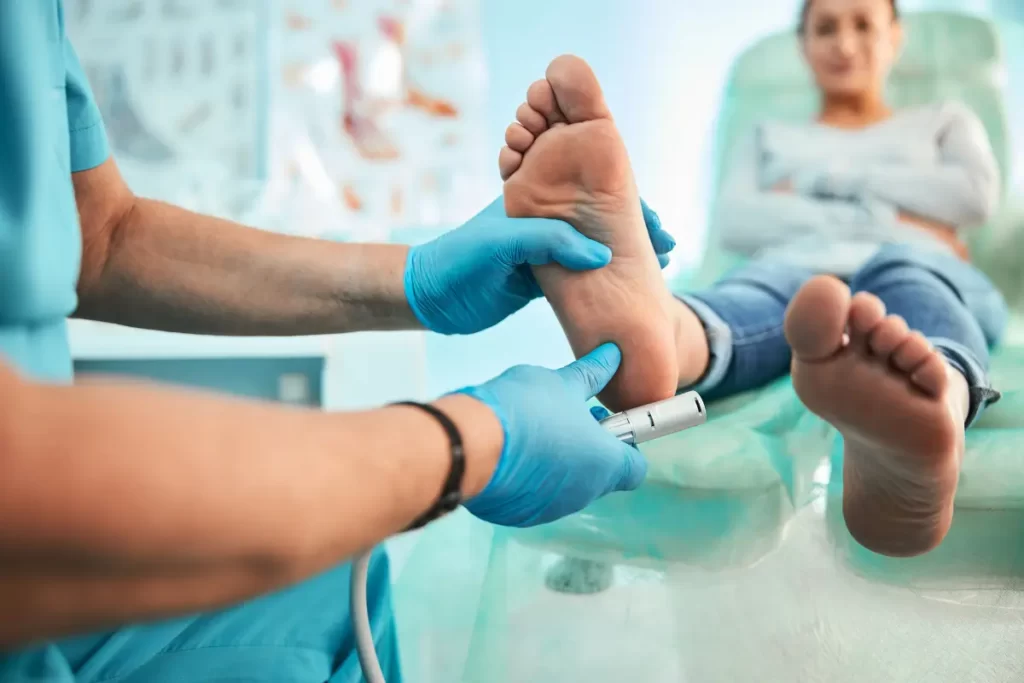Podiatry
A podiatrist specializes in diagnosing, treating, and managing issues and injuries affecting the feet, ankles, legs, and knees, aiming to enhance their function. They assess, diagnose, and treat a variety of foot and lower limb conditions, which may include:
- Skin and Nail Disorders: Such as ingrown toenails, fungal infections, corns, cracked heels, and other related issues.
- Complications from Medical Conditions: Issues arising from conditions like arthritis and diabetes that impact foot health.
- Gait and Posture Problems: Difficulties with walking, running, and posture that affect movement.
- Injuries: Including muscle, tendon, ligament, joint, and bone injuries caused by overuse, resulting in inflammation, tears, fractures, and joint issues.
What is Podiatry?
The feet and ankles are intricate structures essential for our daily movement and support. Given their crucial role in our lives, maintaining good foot health is vital for overall well-being.
Podiatrists possess in-depth expertise in the complexities of the lower limbs, focusing on the assessment, management, and prevention of conditions affecting these areas. Whether it’s alleviating foot pain, managing chronic conditions, or improving overall mobility, podiatry aims to keep you active and comfortable.
- Need Assistance?
(07) 5619-5588
Podiatry Conditions And Care
Ankle rehabilitation might be necessary following surgery, sprains, or fractures, concentrating on improving flexibility, balance, and preventing future injuries. We will develop a tailored and thorough rehabilitation program, which may include taping or bracing to provide optimal support and stability, reducing the likelihood of re-injury.
A biomechanical assessment evaluates joint mobility, foot function, and walking patterns (gait). These factors can significantly affect areas such as the back and knees, making this assessment an essential first step in many situations.
Diabetes presents specific foot risks due to the fragility of blood vessels and nerves, including conditions like peripheral neuropathy, peripheral arterial disease, and other related issues.
We frequently conduct footwear assessments and offer guidance for conditions like Achilles tendonitis, heel pain, metatarsalgia, and others. This often includes recommending orthotics and custom insoles to support the feet and enhance the overall musculoskeletal system.
Our general podiatry care addresses a broad spectrum of foot and ankle issues, ranging from regular check-ups to specific conditions such as plantar fasciitis and heel spurs, all with the goal of maintaining your overall foot health.
We frequently encounter conditions such as ingrown toenails, fungal infections, and bunions, and are committed to improving your foot health while also addressing any cosmetic issues.
How MoveSense helps for Podiatry?
Assessment
We perform a comprehensive evaluation of your foot and lower limb health by analyzing your gait, mobility, and function. This allows us to identify and address a wide range of conditions and offer the most suitable care.
Diagnosis
By diagnosing your foot and lower limb issues, we determine the underlying cause of your condition and develop a customized treatment plan to address your specific needs.
Customized Treatment
Using the assessment and diagnosis information, we create a personalized treatment plan designed to provide you with the most effective care for your recovery.

What happens at a Standard Podiatry Appointment?
During your initial consultation, your new podiatrist will begin by subjectively assessing your needs. They will listen to your concerns and any issues you’ve observed. If this is your first visit, they will also record your medical history and ask questions about your lifestyle and general health.
Your podiatrist may conduct both an objective and a biomechanical assessment.
The objective assessment involves examining your skin’s tone, color, texture, and temperature, and may include neurological and vascular evaluations. This helps identify any underlying or related medical issues and detect any defects.
The biomechanical assessment involves observing your posture, walking pattern, and range of motion.
Based on these assessments, your podiatrist will share their findings, provide a diagnosis if applicable, and discuss the most effective treatment options for your initial concerns and any additional issues uncovered during the appointment.
What issues can be treated in a Standard Podiatry Appointment?
Basic foot care involves a variety of general maintenance tasks. This includes regularly trimming and filing your nails, reducing nail thickness, removing hard skin, and providing general advice on foot care.
These tasks become increasingly important with age, especially if mobility is limited or if performing them yourself becomes challenging.
Weight-bearing areas of your feet are susceptible to corns because of the high pressure in these regions. While some corns may be harmless and cause no significant problems, others can be very painful. Even if your corn isn’t currently causing discomfort, it indicates an underlying issue that should be diagnosed and addressed.
Many of us have encountered those bothersome, unsightly thick yellow patches of skin on our feet. Calluses not only appear unattractive but can also be quite painful. Typically resulting from excessive friction or pressure on a specific area of your foot, calluses can be effectively treated.
Verrucas, often contracted in communal areas such as changing rooms and swimming pools, are caused by a strain of the Human Papilloma Virus. They resemble corns but have a small black dot in the center and can be both painful and embarrassing.
Fungal nail infections are a prevalent issue, affecting 10% of people in Australia. These infections cause nails to turn yellowish-brown, with the affected nails becoming thickened and eventually crumbling. Although the condition is not painful in its initial stages, as the nails thicken, they exert excessive pressure on the nail bed, leading to discomfort.
Athlete’s foot is another frequent foot infection caused by a fungus that typically affects the area where your toes meet your feet. It results in red, flaky, and itchy skin. As the name suggests, athletes are particularly susceptible to this condition. With accurate diagnosis, it can be effectively treated within a few days.
